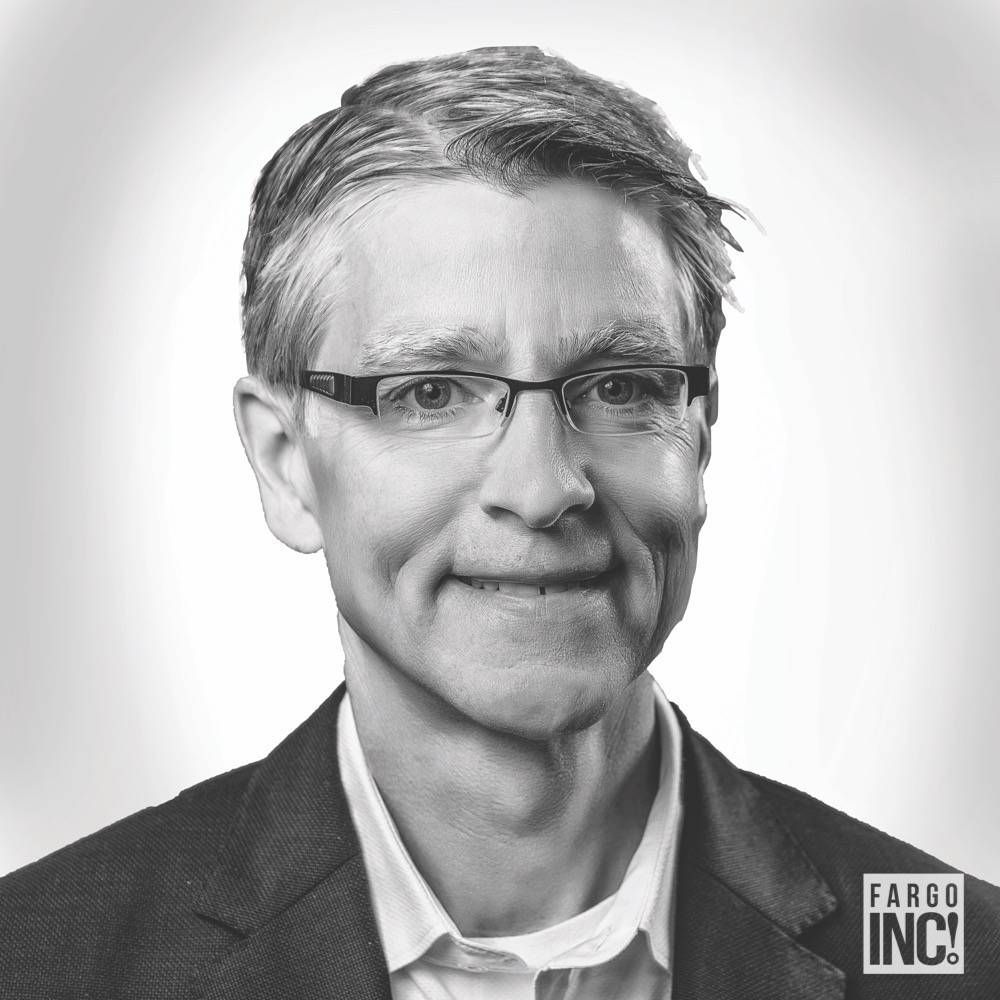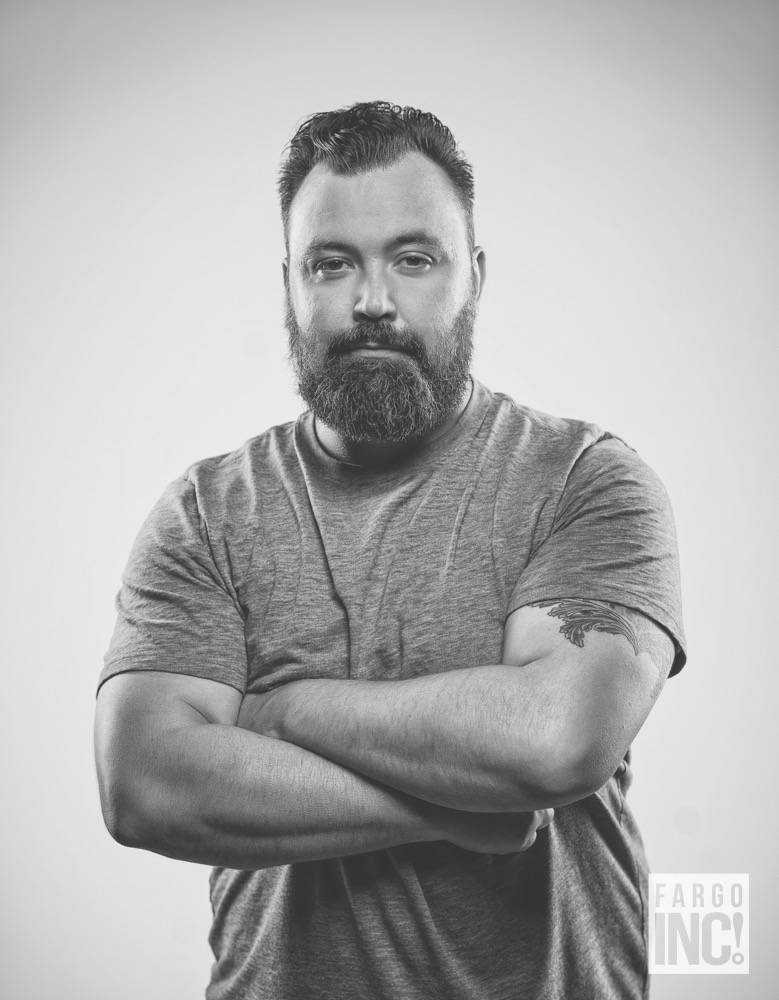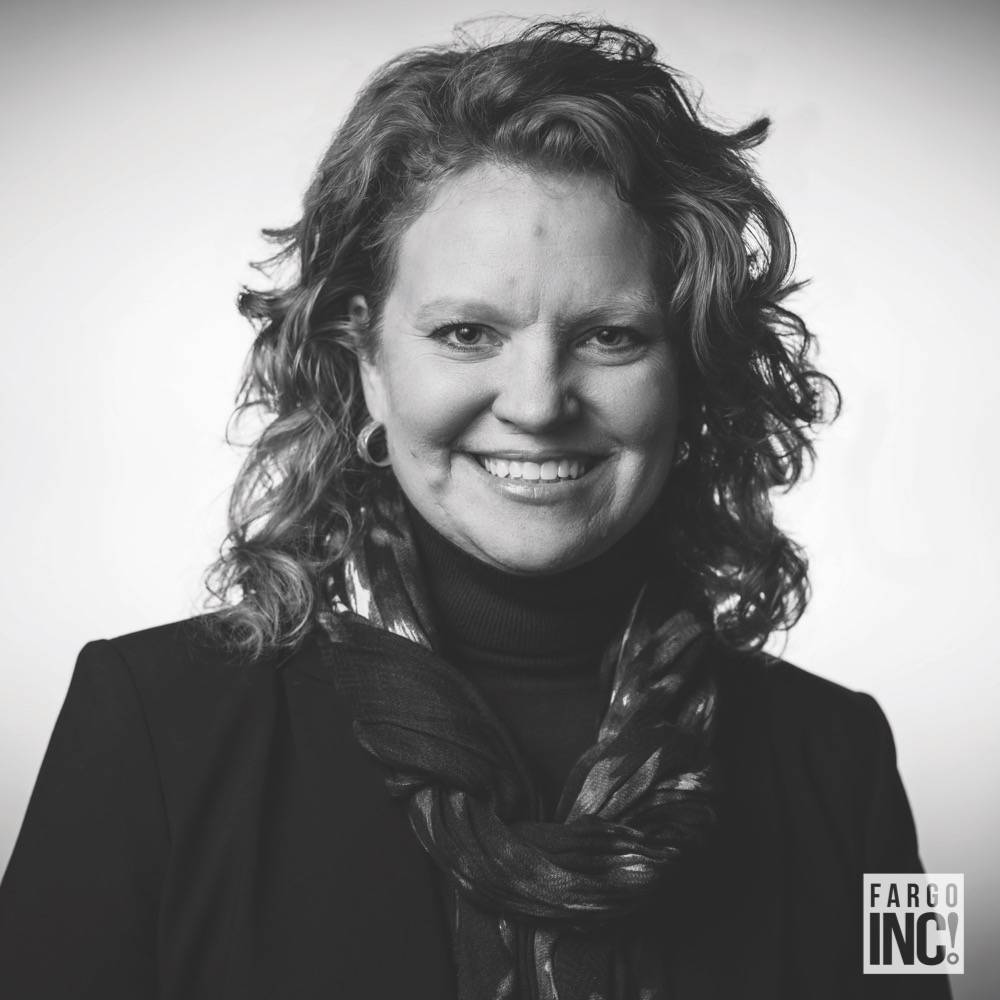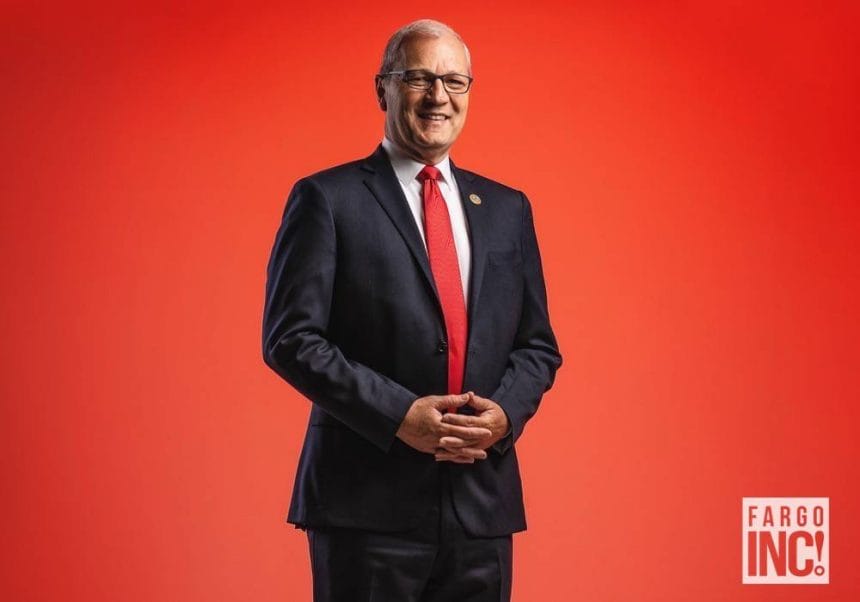Photos by J. Alan Paul Photography, Paul Flessland and special to Fargo INC!
North Dakota is under the political spotlight going into this election season. Turn on any cable news station and it’s not uncommon to hear political pundits talking about the battleground our state has become.
While we don’t endorse any candidate, we wanted to let you meet the two senate candidates, hear their responses of some of your business questions and let you make an informative choice come Tuesday, November 6.
No matter the outcome of this election, there is one thing that we believe is important to note. Toward the end of our interview with North Dakota Senator hopeful Kevin Cramer, he made a good point.
“Every state has a governor but most states have more than 700,000 people. Every state has two senators but most states have more than 700,000 people. We’re fortunate here that access to public officials, to the degree it’s valuable, is easy.”
While North Dakota’s small population can sometimes be a challenge to the business community, especially when it comes to workforce, the accessibility to our political representatives should be looked as one of the major benefits of our state’s small size. States with a large population do not have the accessibility that we have. Considering each state only has two senators, a state like California, for example, has one senator for 19,770,000 people while North Dakota has a senator for every 377,697 people. Don’t forget to look at your political representatives and ask the question about what they’re doing for you.
As the North Dakota senate race heats up and gains national attention, we sat down with Senator Heidi Heitkamp and Congressman Kevin Cramer to discuss what this election could potentially mean for your business.
*Interviews have been edited for clarity and brevity.
Meet The People Behind The Questions
We reached out to a number of business and community leaders for their questions they’d like to ask the candidates.

Greg Tehven, Executive Director at Emerging Prairie

Pat Traynor, Executive Director at Dakota Medical and Impact Foundations

Adam Martin, Founder of F5 Project and F5 Venture Partners

Kirk Anton, Owner of Heat Transfer Warehouse

Jessica Thomasson, CEO at Lutheran Social Services of North Dakota
Meet Kevin Cramer
Hometown: Kindred, North Dakota
College: Bachelor of Arts degree from Concordia College, Master’s degree in Management from the University of Mary and was conferred the degree of Doctor of Leadership, honoris causa, by the University of Mary
Number of years in Congress: 6
Q: What is your favorite way to celebrate North Dakota to your friends in Washington? – Greg Tehven, Executive Director at Emerging Prairie
A: I always like to tell them the story of Eric Sevareid, the famous North Dakota native and CBS correspondent who once referred to North Dakota as the rectangular blank spot of the nation’s consciousness. Now we’re this rectangular stage under the nation’s spotlight. The Bakken sort of shined a bright light on North Dakota but while it was shining on the Bakken, the nation got to see all these other things in our state like Microsoft with the second largest campus outside of Redmond. This attention has spawned this entrepreneurial culture, particularly in the Fargo area but up and down the whole Red River Valley and now throughout the state. I love telling the story of North Dakota and how we were once this sleepy agrarian, but very successful, state. Things like oil, technology, and advanced manufacturing really allowed us to diversify not just our own economy, but the nation’s perspective about us.
Q: There were 14,446 open jobs last month, with your tourism director background, what do we need to do to solve that?
A: I would submit to you that if Job Service North Dakota is listing 14,000 plus jobs, it’s probably more like 45,000 jobs. I’ve looked at the Job Service website. In fact, I’ve looked at several websites and they’ll list a job opening and you know there’s probably 10 or more of them in that category.
What do we do about that? It’s getting harder, because like I said, the workforce challenge is no longer a North Dakota issue or a regional issue, it is now becoming a national challenge. This is what forces wages upward. That’s a challenge to the business owner but it’s an advantage to the worker. You do have to meet that demand.
One of the biggest challenges for North Dakota is getting people here. I think keeping them here is not that challenging. I think that people are often surprised when they get to Fargo and some of our other finer cities.
As a marketer though, you need to have the jobs to offer, which we do. You have to be able to pay enough to attract job seekers in a competitive market and I think that’s a bigger challenge. In our favor, we have a high quality of life here. When they see great big beautiful hospitals, successful universities and a successful startup technology entrepreneurial culture, they want to be here.
“We need a lot of people with CDLs, not MBAs.”
Here’s another thing I would say that gets wonky but it’s a very real issue. It’s one of my biggest challenges, maybe even frustrations, since being elected to Congress. Our approach to immigration and immigration reform is very challenging. We have an immigration system that is, by any global measure, very liberal. We accept a million legal immigrants a year but there’s no connection between our policy and workforce requirements.
Here in Fargo, you have Microsoft employing with a whole bunch of workers with H1-B Visas which allow companies to employ foreign workers in specialty occupations. These workers, who are not only some of the smartest people in the world but some of the most ambitious are also very patriotic and some of the nicest people with great creative ideas. Yet we stifle their opportunity to contribute to our culture and our own economy with all the rules. Per country caps, for example, are the maximum number of family-sponsored and employment-based preference visas that can be issued to citizens of any country in a fiscal year. The limits are calculated each fiscal year depending on the total number of family-sponsored and employment-based visas available. These rules prevent, say, a software engineer from Pakistan or a physician or surgeon from India from letting them really grow themselves and their offerings, including their spouse’s ability to work.
We need to eliminate per country caps or at least make them more flexible so that these people can get not just a worker visa, but rather a Green Card and work toward citizenship. Right now, we have Indians who would be on a 75- year waiting list to get a Green Card and they’re some of the most productive contributors to our society and our economy. I think we need a merit-based immigrant system with more flexibility and we need to eliminate the per country caps. This will allow us, not just to attract a good workforce, but attract the workforce that is in demand and allow us to grow our economy.
That’s a big part of the problem. This is an area, frankly, where the President and I disagree. There’s a sense in the administration that we ought to both lower the number of immigrants and have a merit-based system. I think we ought to have a merit-based immigration system but we shouldn’t lower the number. In fact, I don’t know why you would confine yourself to a number if you have more job openings than people looking for work.
Today, we have 6.6 million job openings in the United States. We only have about six million people looking for work but we have tens of millions more who don’t work yet are capable of work. They don’t have the skillset, education or background that allows them to work in high-demand jobs. That’s a failure of education. We’ve put way too much emphasis at many of our universities on four-year degrees and MBAs and not on the skill sets that are in high demand. We need a lot of people with CDLs, not MBAs. We’re pushing too many people into MBAs.
This is a failure of higher education. That’s why in this most recent Congress, the President signed the Carl Perkins Act into law. This skill training technical education reauthorization will put more emphasis and resources toward skills training, and more employers on the advisory boards so we can emphasize the skills and technology training that our economy needs.
Carl Perkins Act:
President Trump renewed this act, which is a $1.2 billion program last overhauled by Congress in 2006. The new law allows states to set their own goals for career and technical education programs without the education secretary’s approval, requires them to make progress toward those goals and make other changes to federal CTE law.
In addition, we have a lot of Americans who aren’t looking for work because we have so many incentives for people to not work. When these incentives exist, there are going to be a lot of people who prefer not to work. On the other hand, we also aren’t providing the tools, education, emphasis and encouragement for people to go to the skilled trades and we need a lot of people in those areas. My dad was a rural electric lineman and he made a great living our entire life. He worked really hard to do it and he met a demand that was great in our community.
Timeline
- 1991: Elected Chairman of the North Dakota Republican Party
- 1993-1997: State Tourism Director
- 1997-2000: State Economic Development & Finance Director
- 2000-2003: Executive Director of the Harold Schafer Leadership Foundation, which connects emerging leaders from the University of Mary in Bismarck with community business leaders
- 2004: Elected to Public Service Commission
- 2012: Elected to the U.S. House of Representatives
Q: It has been proven that good prison reentry programs, good work force training both inside and outside the prison has helped decrease unemployment jobs for citizens with felony backgrounds. It also shows when treatment is approached, rather than punitive measures, recidivism rates go down, which directly affects our communities’ health in regards to crime and substance abuse. What are you doing to help create more work force and treatment options for citizens that are filling the employment gap within our state? – Adam Martin, Founder of F5 Project and F5 Venture Partners
A: There needs to be an institutional discipline about it and some guidance to make people comfortable about it. I always say, I would prefer to invest in your education rather than your incarceration. The goal of our justice system should be rehabilitation and making productive members of society, not punitive. We incarcerate way too many people for things that are not related to other people’s danger. I’m a law and order guy, particularly when it comes to violent crimes. But addiction, drug abuse and alcohol abuse is a different story. Kris and I had a son who died earlier this year from alcohol induced liver failure. We’re very familiar with it. She was with Teen Challenge and I was Chairman of the Board at Teen Challenge, a faith-based addiction recovery ministry. With programs like this, you see much opportunity for effective recovery.
From an employer standpoint, you look at it as human capital that could be helpful in your business. As somebody who cares about justice or society, which are usually the same people, you look at it and go, ‘Look at all the human potential and the problems they solve.’
I’ll give you a specific example. When I first introduced H.R.5 in my second term, a bill to advance the XL Pipeline, we had a debate on the floor. It was my bill, so I was on the floor providing an explanation in order to encourage it. The democratic leader in this particular debate yielded three minutes to the gentleman from Georgia, Mr. Scott. I had never met David Scott before. He is an African-American Democrat with a deep voice. He gets up and says, ‘What we need in America is more jobs for young black men. We don’t have a good jobs program. The Keystone XL Pipeline is a jobs program.’
I was stunned. He’s taking three minutes of the opposition’s time to speak on behalf of my bill and I never met the guy. His perspective was as a pro-union, black, Democrat from the city of Atlanta, Georgia. You couldn’t be more different than I am. He is now one of my dearest friends and just earlier this week during opening comments on the Farm Bill Conference Committee, he spoke about our work to put more money into black land-grant universities for scholarships to go study horticulture, ag economics and other workforce areas that are important in agriculture.
Why did he and I create such a friendship? For him, it was about lifting up his constituency, particularly young black males. He goes through the statistics of how many young black men are in prison, how many young black women have children by these young black men who are in prison, and that the real issue in the inner city is poverty and the lack of jobs, not racism. All of these other things come with it. I’m talking about how we can get more people working.
Population per Senate seat
- North Dakota: 377,697
- South Dakota: 434,833
- Montana: 525,000
- Minnesota: 2,788,500
- Ohio: 5,830,000
- California: 19,770,000
Q: Addiction, substance abuse and untreated mental health issues present very real challenges in our state’s schools and workplaces. What will you do to help create a first class modern behavioral health system in ND to help address these issues? – Jessica Thomasson, CEO at Lutheran Social Services of North Dakota
A: I think eliminating stigma is a big part of it. I have a very complex family structure. Kris had two sons when we were married, who I adopted. We had two daughters together and then we adopted a little boy after he witnessed his mother’s murder, now he’s 11. We have this very spread out family with four grandchildren and one on the way. We’ve seen it all and we see it all every day.
Mental illness is very real, obviously, but the addiction issues we deal with are so pervasive that these are community challenges, more than government challenges. On the federal level, what we can do and are doing are things like monitoring, overseeing, providing policy when necessary to reign in the overprescribing of addictive drugs, particularly the opioids. We also make sure we have adequate beds. There’s a huge shortage of beds for psychiatric care. We can build prisons but we have a hard time putting in enough beds, which we did a couple of years ago in a bill called the 21st Century Cures Act, which came out of a committee I serve on. It passed in the House and the Senate took it up and they modified it but we did eventually get it done and the President signed it. One of the things we added was a bill I cosponsored, specific to this point of providing more resources for beds and more treatment centers plus an emphasis on community-based treatment, rather than these large institutional treatments.
21st-Century Cures Act:
Signed into law on December 13, 2016, promotes and funds the acceleration of research into preventing and curing serious illnesses; accelerates drug and medical device development; attempts to address the opioid abuse crisis; and tries to improve mental health service delivery.
The prevention side is even more important. I think we need to always aim to prevent addiction, even though addiction is often largely chemical or it might be hereditary in some cases. And then we need to place a stronger emphasis on treatment rather than incarceration and then provide our police officers and law enforcement officers the tools that they need.
But then we also need to deal with the supply side. We need to decrease the number of things they get addicted to and that means border security and tighter controls of what comes into our country by making sure law enforcement has the tools they need. If we could kill the demand for the product, there would be no need to worry about the drug dealers if nobody is there to buy it.
It has to be comprehensive. A lot of people like to focus on one or the other. Some people are totally focused on enforcement. Some people are totally focused on treatment. I always think let’s start with prevention and go from there.
Q: What do you believe is the best way to alleviate poverty? – Pat Traynor, Executive Director at Dakota Medical and Impact Foundations
A: Jobs. I think it is comprehensive. It’s a lot of things we’ve talked about. We have the jobs. We need to have an education system that educates people for the jobs that are open. Frankly, we have to be more efficient within our education system. It sounds harsh, but university presidents love to fill their chairs and have people take five years to get a four-year degree. We need to institutionalize more efficiency in our university system and then make sure people are getting appropriate guidance at younger ages. I think a lot of it starts in high school. We need to expose young people to more realistic employment opportunities and have a clearer picture of what’s available. It’s comprehensive.
This is why I’m happy to run on a platform that has created a lot of jobs by rolling back regulations, cutting taxes for corporations and individuals. This makes it more profitable to create jobs so that the jobs are available. However, we have to have an education system that matches that. We have great education in North Dakota, and Fargo offers a lot of opportunities. Tony Grindberg is doing a wonderful job through the State College of Science and his program up here.
Q: With the new sales tax legislation coming state by state, how do you view that will affect e-commerce and help business grow in North Dakota? Will it be too complicated and cause hardship on businesses? – Kirk Anton, Owner of Heat Transfer Warehouse
FYI: Since e-commerce’s inception, one of its most appealing aspects was that shoppers didn’t have to pay sales tax. In June, the Supreme Court ruled that internet retailers can now be required to pay sales tax, even in states where they have no physical presence. While there is a lot of confusion over this, the big question remains what will be the threshold for when a company has to pay sales tax.
A: It’s interesting to see what the Supreme Court did because this was a reversal. The Supreme Court rarely reverses a previous Supreme Court ruling. The only way they can, in fact, based on precedent setting law, is if circumstances have changed dramatically enough or there’s new information. Clearly, technology and e-commerce have created new circumstances. The original law in the original lawsuit was based on magazine orders, not online orders.
How will it affect e-commerce? Not much, I don’t think. I think 10 years ago, it would have affected it a lot. E-commerce is becoming the preferred commerce. Let’s face it, retail is in a tough, tough spot and the trend is not going away. The trend is going further toward e-commerce. I think the culture and the marketplace are good for e-commerce and I don’t think the Supreme Court decision will slow it down much.
I think we have to step in and set some basic standards. Since I have been elected to Congress, I have believed that we have to protect the startup, the small e-commerce company. If we apply the same standard to a company that does half a million, or even a couple million dollars, out of their garage or their basement as we do to Amazon, then we’re giving Amazon all the advantages. All the regulations do that. Regulations, taxes and tax policies are always easier for big companies to take advantage of than small ones. They become barriers to entry into the marketplace.
I would set a very high threshold before the tax policy kicks in. I would like to see at least $5 million, maybe even $10 million. I think there’s a big gap between Sam’s Club, Amazon and Best Buy and the person who is making children’s clothing or pillows in their basement. Otherwise, you’re going to see a gobbling up.
Regulations are always a barrier to entry. That doesn’t matter if you’re a welder, you’re a small neighborhood grocery store, you’re an auctioneer, you’re an e-commerce company or a healthcare facility. The more regulations and the more taxes there are, the better it is for the Sanford Health than it is for the small clinic. I think we have to set thresholds that tear down barriers to entry. Otherwise, you’re just going to have a bunch of monopolies and it’s going to be a lot harder for people to get started in business.

President Donald Trump has come to Fargo twice this year to campaign on behalf of Congressman Cramer.
Q: What resources are out there that businesses and business owners are taking advantage of?
A: Every state has a governor but most states have more than 700,000 citizens. Every state has two senators but most states have more than 700,000 people. We’re fortunate here in North Dakota that access to public officials is relatively easy. I would say from a constituent standpoint as a congressman, I do a ton of work. Probably most of our constituent work is with veterans and the second is with immigration and that means helping somebody get their H-2A visa available for the seasonal visa or a H-2B. A lot of work is done with the H-1B visa in the high-tech area and helping them get their family members into the country. Sometimes, it’s a regulatory issue that we’re able to intervene on. The business owners and the business people who have gotten to know their members of Congress, their governor along with the attorney general and others that can be helpful in the various industries are all a resource that can be very helpful. We are a small state compared to other places and we all see ourselves in it together. We’re very patriotic. I think our access to each other is pretty cool. I think it’s an asset that businesses can take advantage of.








